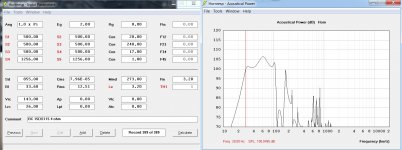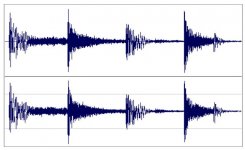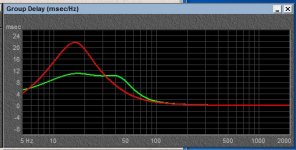Dear all,
How much GROUP DELAY is acceptable in a PORTED SUB to have good TRANSIENT RESPONSE?
The goal is to design a sub with tight bass to the extent possible.
The sub should work reasonably "ok" for both movies and music in a HT.
I know everything is a trade off in subwoofer design and the room modes play a role too.
But in the design phase, "in a very general sense" what is the maximum group delay we can restrict to?
As an example.... in the attached image, RED is large box tuned to 25hz
And GREEN is small box tuned to 36hz. Obviously GREEN graph has better transient response. But how much group delay is too much in general ??
Thanks & Regards,
Audfrknaveen
How much GROUP DELAY is acceptable in a PORTED SUB to have good TRANSIENT RESPONSE?
The goal is to design a sub with tight bass to the extent possible.
The sub should work reasonably "ok" for both movies and music in a HT.
I know everything is a trade off in subwoofer design and the room modes play a role too.
But in the design phase, "in a very general sense" what is the maximum group delay we can restrict to?
As an example.... in the attached image, RED is large box tuned to 25hz
And GREEN is small box tuned to 36hz. Obviously GREEN graph has better transient response. But how much group delay is too much in general ??
Thanks & Regards,
Audfrknaveen
Attachments
Actually it’s the red line that has the best group delay not the green.. to understand this you need to know where most of the bass frequencies are in movies and music.
These frequencies tend to be at above 30hz and below 100 hi with a very strong bias for the 40 to 80 area
All these places are where the red line is lower than the green.
Also to throw another one in, the lower the frequency the higher the output has to be for your ears to hear it. And group delay is less important.
So basically, go big and tune low. A 20hz tune is good for movies and music.. the group delay won’t really get going for music
These frequencies tend to be at above 30hz and below 100 hi with a very strong bias for the 40 to 80 area
All these places are where the red line is lower than the green.
Also to throw another one in, the lower the frequency the higher the output has to be for your ears to hear it. And group delay is less important.
So basically, go big and tune low. A 20hz tune is good for movies and music.. the group delay won’t really get going for music
hi trojantrow - what is your take on assisted 6h order bass reflex? I think but can't prove some of those will in practice, sound "tight".
of course the example below at ~42Hz tuning isn't subwoofer territory - but IIRC, close to some of the old EV Interface designs
such as Interface B.

of course the example below at ~42Hz tuning isn't subwoofer territory - but IIRC, close to some of the old EV Interface designs
such as Interface B.

Last edited:
Actually it’s the red line that has the best group delay not the green.. to understand this you need to know where most of the bass frequencies are in movies and music.
These frequencies tend to be at above 30hz and below 100 hi with a very strong bias for the 40 to 80 area
All these places are where the red line is lower than the green.
Also to throw another one in, the lower the frequency the higher the output has to be for your ears to hear it. And group delay is less important.
So basically, go big and tune low. A 20hz tune is good for movies and music.. the group delay won’t really get going for music
Thats an interesting point. !!! Thanks a lot.
I agree with the above also... the tight bass muddy bass myth.
E.g I run a DIY alpine swr1542D in a sealed box.
I have room correction built in to my anthem AVR.i can have it sounding tight and not able to locate the sub.
Or. Do it wrong and it’s muddy and horrible.
Spend more time getting the crossover to the mains correct and the slopes of the crossovers correct and it will sound good, don’t worry about that.
E.g I run a DIY alpine swr1542D in a sealed box.
I have room correction built in to my anthem AVR.i can have it sounding tight and not able to locate the sub.
Or. Do it wrong and it’s muddy and horrible.
Spend more time getting the crossover to the mains correct and the slopes of the crossovers correct and it will sound good, don’t worry about that.

Simulation.
ROAR with Helmholtz front resonator
Layout, prototype of something similar but with another driver and passband, and measurements of the prototype.
With a pronounced peak centered around the midbass you get a very tight punchy and tactile character. Very usable for both music and HT.
Bass reflex has its limitations in "tightness" and punch suitable for HT. A driver suitable for BR has to much moving mass and to little Bl for a good mid bass punch and perceived tightness. The port in a BR takes several wavelengths to reach peak amplitude - which is pretty much the opposite of "tightness".
Last edited:
Nothing, except designing the subwoofer such that it does not produce bass.room modes are definitely important!!! . Im trying to understand what care we can take before building the box to make it sound less boomy.
hi trojantrow - what is your take on assisted 6h order bass reflex? I think but can't prove some of those will in practice, sound "tight".
of course the example below at ~42Hz tuning isn't subwoofer territory - but IIRC, close to some of the old EV Interface designs
such as Interface B.

Hi freddi.
I wish I could help you but what I’m sharing here is just what I have learned from constant reading and first hand experience. I don’t actually know I lot about the different types of subwoofer design. At all
Wish I did and wish I had the skills to build them.
I ended up going with a simple strategy
Pick a good big driver
Build the right size good sealed box
Make sure it’s set up right.
Sounds good as well. Better than subs that cost a lot more
Wish I could help you more but hopefully someone will come a long with much more experience than me to help you out
View attachment 755182
Bass reflex has its limitations in "tightness" and punch suitable for HT. A driver suitable for BR has to much moving mass and to little Bl for a good mid bass punch and perceived tightness. The port in a BR takes several wavelengths to reach peak amplitude - which is pretty much the opposite of "tightness".
Even bass notes dont build up suddenly and take time. They dont have 'transients', the transient is a higher frequency phenomenon. So why does "BR takes several wavelengths to reach peak amplitude" matter? Isnt it true that our ears can only detect bass after a few cycles only and not before, this is the whole reason why multi sub setups work. And given that muti sub works the few cycles build up of a tome does not matter.
Also can you point out some measurements/studies which suggest that BR takes more cycles than a TH or its variant?
@ wonderfulaudio
Every speaker starts at 0 time. And reaches peak value at the indicated group delay value (x ms). It does not start to play later. It reaches its steady state at that point of time. They all start to play at 0, instantly when the signal is given. That's what people usually do not understand about phase. So the proof is the GD-graph itself.
cheers
Josh
Every speaker starts at 0 time. And reaches peak value at the indicated group delay value (x ms). It does not start to play later. It reaches its steady state at that point of time. They all start to play at 0, instantly when the signal is given. That's what people usually do not understand about phase. So the proof is the GD-graph itself.
cheers
Josh
Agreed.Every speaker starts at 0 time.
It reaches peak at some time but thats not the group delay. Group delay is the measure of phase change AT that frequency, not peak time of tone buildup.And reaches peak value at the indicated group delay value (x ms).
Agreed.It does not start to play later.
No, already mentioned above.It reaches its steady state at that point of time.
Agreed.They all start to play at 0, instantly when the signal is given.
But Joshcpct, whats your point?
Even bass notes dont build up suddenly and take time. They dont have 'transients', the transient is a higher frequency phenomenon
The why would a well designed basshorn have a better subjective "transient response" when reproducing the bass from a kickdrum then any numbers of 218 BR boxes? (both LP at 100 Hz 24 dB/octave)
Why did audfrknaveen specify "good TRANSIENT RESPONSE" in the name of this thread if bass is only steady state sine waves or similar droning sounds where "transient response" only effect higher frequencies?

The wave shape of drums sure looks like transient peaks with a reverberant decay to me..... Those transients does define the sound of a drum. Take the transients away and it becomes a somewhat complex decaying sinewave oscillator.
And if you want to make the transients a pure high frequency component then please explain how a 1 inch dome can displace the same amount of air as the skin of a hard driven kick drum in a matter of a few microseconds?!?
Agreed.The wave shape of drums sure looks like transient peaks with a reverberant decay to me..... Those transients does define the sound of a drum. Take the transients away and it becomes a somewhat complex decaying sinewave oscillator.
No, I didnt intend to mean this.And if you want to make the transients a pure high frequency component then please explain how a 1 inch dome can displace the same amount of air as the skin of a hard driven kick drum in a matter of a few microseconds?!?
The drum produces a complex music. It has more lows, little midrange and very little treble too. A 1" tweeter CAN reproduce the harmonics of a drum. An FFT can show the frequency spectrum, pls see frequency domain, not time domain. To reproduce a drum faithfully, a much wider bandwidth is needed, from lows to mids to highs. The drum has lots of energy in the lows needing a big LF source to reproduce, this LF source does not need to have the kind of transient response being discussed here. The mid components will need a midrange, and the highs will need a tweeter. The whole spectrum is now reproduced and appears similar to the graph you have shown.
As to why horns are preferred is another story and I dont understand that and am looking for somebody more knowledgeable to explain.
Maybe phase, maybe dynamics, maybe distortion, I dont know.
But its certainly not the transients.
Last edited:
Bass reflex cabinets have relatively poor transient response, causing "smearing" or a longer resonance of the bass notes. Though the sound coming out of the port may have the same phase of that from the front surface, but it can never be at the same time, thus, the extended bass energy is really noise disguised as signal. The disguise works only when the sound is a continuous tone
Bass reflex - Wikipedia
The drum has lots of energy in the lows needing a big LF source to reproduce, this LF source does not need to have the kind of transient response being discussed here
If you want to have a good reproduction of a kick drum, then you have to displace a lot of air in a few milliseconds, in the same way a hard kick to a large drum skin will do.
If the bass driver is bandwidth limited and the midrange and treble is displacement limited then the loudspeaker can not reproduce a kick drum....
And since the bass reflex port will lag in its response to the driver, it can not reproduce the transient part of a kick drum with any reasonably definition of a "good transient response".
An FFT will prove that this is not the case. A drum FFT will show more SPL at lows, little at midrange and very little at treble. The energy is very little energy in the treble even for a drum. Since we are discussing spectrum we need to see frequency domain, trying to explain in time domain is going to cause confusion.If you want to have a good reproduction of a kick drum, then you have to displace a lot of air in a few milliseconds, in the same way a hard kick to a large drum skin will do.
If the bass driver is bandwidth limited and the midrange and treble is displacement limited then the loudspeaker can not reproduce a kick drum....
And since the bass reflex port will lag in its response to the driver, it can not reproduce the transient part of a kick drum with any reasonably definition of a "good transient response".
BR Helmoltz covers a very small bandwidth, a spectrum where the human ear is very insensitive to GD. If the Helmholtz energy buildup is quicker than the drum (in terms of LF cycles) then whats the problem? Where is the data that this is a problem and BR fails there?
Above the helmholtz frequency, its a sealed system so no point discussing that.
Why did audfrknaveen specify "good TRANSIENT RESPONSE" in the name of this thread if bass is only steady state sine waves or similar droning sounds where "transient response" only effect higher frequencies?
That could be the cause of the confusion, his first question makes sense though. Transient response is a measure of the whole system, not the sub
for what little its worth, for dynamics, I prefer the old (1951 year of K15's prototype) copuled-cavity Karlson box to BR which cover the same range - but its not a subwoofer, and does not play "low" It can do well on kick drum, bowed and plucked bass viola, cello and with drums. The aperture is part of its system tuning and can affect the subjective outcome. If the inner vent is placed above the woofer, then the upper- narrow portion of the aperture can affect "air" and tone - maybe system damping. I've seen K15 exhibit noticeable reduction of sideband amplitude when driving with two sine tones compared to reflex. They can but don't necessarily exhibit dips in their response and part of their character as originally intended was to "enhance" (Karlson called it ""controlled ring" the overall sound from bouncing and rattling around in the front chamber. There isn't a direct means I know of to design the things (it can be done in some degree with Akabak but suspect chamber aspect and front cavity shape/depth can play some significant role in the outcome.
Last edited:
- Status
- This old topic is closed. If you want to reopen this topic, contact a moderator using the "Report Post" button.
- Home
- Loudspeakers
- Subwoofers
- Ported sub with good transient response
